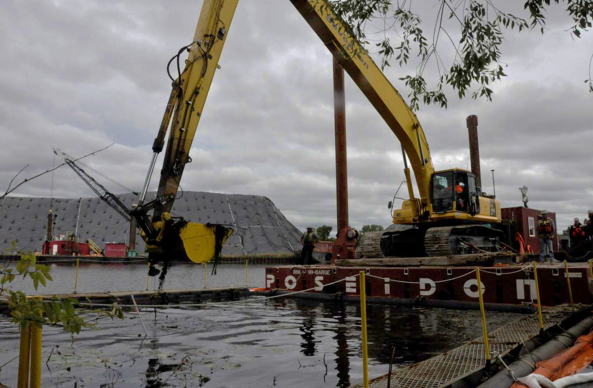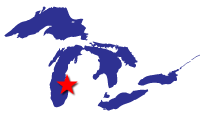Muskegon Lake AOC
Contact: Mark Loomis
([email protected])
312-886-0406
Latest News
Overview
Muskegon Lake is a 4,149-acre drowned river mouth lake that flows into the eastern shore of Lake Michigan. Muskegon Lake was designated an AOC through the Great Lakes Water Quality Agreement in 1987 due to ecological problems caused by:
- Historical industrial discharges of pollutants into the AOC
- Shoreline development and hardening
- Historic sawmill debris, foundry sand and slag filling open water and coastal wetlands
- Localized groundwater contamination moving toward the lake and its tributaries
This resulted in:
- Sediment contaminated with petroleum hydrocarbons, mercury, lead, other heavy metals, oil, PAHs, and PCBs
- Excessive fill and loss of natural shorelines along Muskegon Lake and large-scale impacts to critical wetlands
- High levels of nutrients, solids, and toxics entering the lake
- Degradation of water quality
Muskegon Lake is now seeing the community benefits from restoration and remediation being conducted in the AOC. Recreational use of the rivers and Muskegon Lake by residents and visitors has increased, tourism is up, and property values have grown.
Beneficial Use Impairments
A good sign cleanup and restoration work is succeeding is the removal of Beneficial Use Impairments (BUIs). As cleanup work is completed, and monitoring demonstrates sufficient environmental health improvements, BUIs can gradually be removed. Of up to 14 possible BUIs, Muskegon Lake was initially designated as having nine impaired. This AOC has removed five BUIs and has four more to eliminate. See the list below. Once all BUIs are removed, the process of delisting the AOC can begin.
- Beach closings - Removed August 2015
- Restrictions on Fish and Wildlife Consumption – Removed February 2013
- Eutrophication or Undesirable Algae - Removed March 2024
- Restrictions on Drinking Water Consumption, or Taste and Odor – Removed February 2013
- Degradation of Fish and Wildlife Populations
- Degradation of Aesthetics (pdf) - Removed October 2021
- Degradation of Benthos – Removed October 2024
- Restrictions on Dredging Activities - Removed September 2011
- Loss of Fish and Wildlife Habitat
- General information about BUIs: Beneficial Use Impairments for the Great Lakes AOCs.
Remediation and Restoration Work
Due to collaboration between numerous federal, state and local partners, all on-the-ground projects, or Management Actions, have been completed at the Muskegon Lake AOC as of September 2021.
The Great Lakes Legacy Act (GLLA) provided funding for four sediment remediation projects in the Muskegon Lake AOC. GLLA project areas included Ruddiman Creek, Division Street Outfall, Former Zephyr Oil Refinery, and Ryerson Creek Outfall. Over 190,000 cubic yards of sediment contaminated with PCBs, PAHs, heavy metals, mercury, and petroleum were remediated. Addressing contaminated sediments at these sites helped restore habitat for benthic invertebrates and fish and wildlife within the AOC. The total cost of the sediment remediation projects was approximately $47 million. EPA provided over $30 million in funding under the GLLA cost-share program. State and local partners provided an additional $16 million through in-kind and cash contributions.
In addition to contaminated sediment work, seven habitat restoration projects were completed in the AOC. These projects restored approximately 134 acres of habitat, including nearly 100 acres of open water and emergent wetlands, as well as well as aquatic fish habitat and upland habitat for native plants. 6,700 linear feet of shoreline was also restored. Additionally, over 110,000 tons of logging-era sawmill debris was removed from the lake, restoring benthic habitat for bottom-dwelling invertebrates and open-water habitat for fish and wildlife populations. Other project goals in the AOC involved the removal of an aging water control structure between the north end of the lake and the Muskegon River, allowing for increased fish passage. 1,400 feet of a concrete wall blocking portions of Ruddiman Creek from the lake was also removed, restoring a healthy hydrologic connection between the two bodies of water while also allowing for increased fish passage. These projects, which cost a total of $22.9 million, have helped create a healthier and more vibrant lake that can successfully support native fish and wildlife populations. Not only will these projects enhance environmental productivity, but they will also add significant socioeconomic value to the surrounding communities.
- Documents on Restoring the Muskegon Lake AOC
- Remediation and Restoration Projects for Muskegon Lake AOC
Sediment Remediation Project Highlight: Ryerson Creek Great Lakes Legacy Act

The final sediment remediation project at the AOC was completed at Ryerson Creek Outfall in November 2020. Sediment in the creek was contaminated with PAHs, heavy metals, and petroleum. Contamination was largely due to sewer overflows and legacy industries, although the creek itself had low pollution levels. 10,600 cubic yards of sediment were mechanically dredged, and 2,000 tons of mill debris were removed. Additionally, clean sand was placed as a cover over the entire 2-acre area, which will help restore benthos in the lake and decrease contamination in the surrounding shoreline of Muskegon Lake. EPA completed the $6.6 million cleanup in collaboration with the Michigan Department of Environment, Great Lakes and Energy (EGLE), Muskegon County, and an industry partner. EPA provided $4.3 million through the GLRI, and EGLE provided $1.2 million in cash and in-kind contributions, with the remainder provided through in-kind services from Muskegon County and the industrial partner.
Restoration Project Highlight: Lower Muskegon River Habitat Restoration
A habitat restoration was completed in the Muskegon River in 2020. The site, a half mile upstream from Muskegon Lake, was a former celery farm separated by the river by three concrete dikes. NOAA completed this project in collaboration with a Regional Partnership with the Great Lakes Commission (GLC) under a $3.1 million GLRI grant. The project was locally managed and implemented by the West Michigan Shoreline Regional Development Commission. This project removed the dikes, reestablishing hydrological connection between the river and the lake, which will help increase fish passage in the AOC. Over 53 acres of emergent wetland were restored by creating emergent wet meadow, shrub, and floodplain forested wetlands. Over 34,000 native plants and 160 habitat structures were installed, providing habitat for fish, bird, and reptile populations. This project also removed 5.3 acres of fill and softened 2,700 linear feet of shoreline. These upgrades will enhance the Muskegon Lake fishery and increase recreation opportunities like canoeing and kayaking on the Muskegon River.

Partners
The following links exit the site
- City of Muskegon
- Grand Valley State University
- Great Lakes Commission
- Illinois-Indiana Sea Grant
- Michigan Department of Community Health
- Michigan Department of Environment, Great Lakes and Energy
- West Michigan Shoreline Regional Development Commission
- Muskegon County
- Muskegon Charter Township
- Muskegon Lake Watershed Partnership


